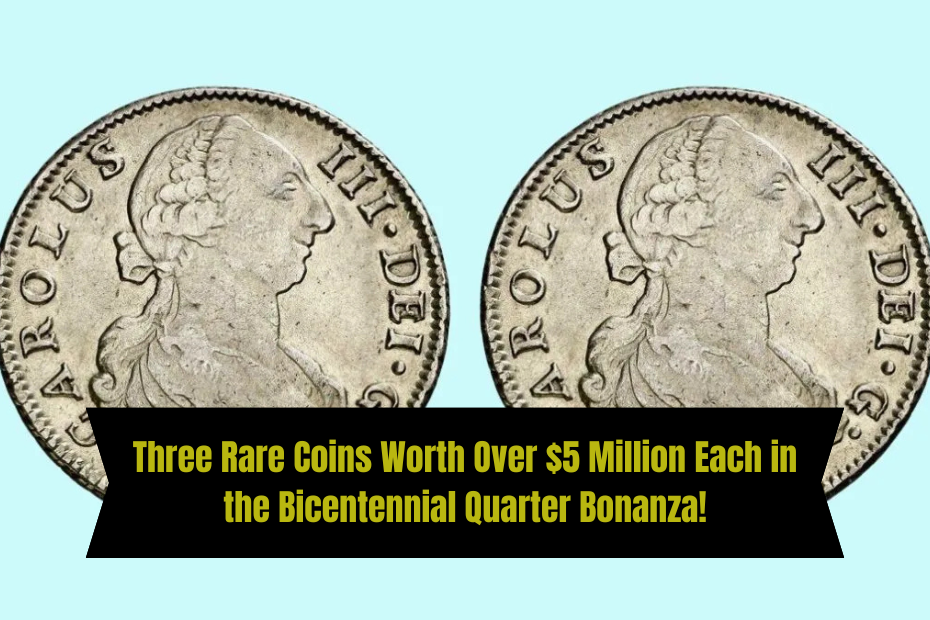The world of coin collecting is captivating, as even the most basic pieces of currency can contain concealed stories, historical intrigue, and, in rare instances, life-changing value. The 1976 Bicentennial quarters are a highly sought-after item for collectors and treasure hunters. These quarters, which were issued to commemorate the 200th anniversary of the United States, were distinguished from conventional quarters by their distinctive drummer boy design.
Although the majority of Bicentennial quarters are worth their face value, a small number are exceedingly uncommon and can be sold for over $5 million each. In this section, we will investigate the top three rare Bicentennial quarters, their identification, and the factors that render them valuable.
The Origins of Bicentennial Quarters
The U.S. Mint released a unique series of coins in 1975 and 1976 in celebration of America’s Bicentennial. This series included quarters, half dollars, and dollars. In place of the conventional eagle design on the reverse, the Bicentennial quarter depicts a drummer child with a torch, surrounded by 13 stars that symbolize the original colonies. These coins were immediately identifiable due to their distinctive design, which served as a tribute to American heritage and a tangible piece of living history.
Despite the production of millions of Bicentennial quarters, only a small number have achieved extraordinary value as a result of their distinctive features. These few quarters are worth significantly more than their gold value due to their exceptional compositions, uncommon mint errors, and high-grade conditions.
The Three Most Valuable Bicentennial Quarters
Although the majority of Bicentennial quarters are still in circulation as regular currency, these three uncommon coins are the exception. Each coin is valued at over $5 million as a result of its rarity, condition, or unique minting features.
1. The Bicentennial Quarter of the Double-Die Error
The double-die error coin is one of the most uncommon variants of the Bicentennial quarter. This form of error occurs during the minting process when the die is struck twice, resulting in a “doubled” appearance of letters, numbers, or images on the coin.
A double-die defect on either side of the Bicentennial quarter is an exceedingly uncommon discovery. The rarity of these coins in high grade renders them exceedingly valuable. Due to its rarity and the collector demand for error coins, a well-preserved double-die error Bicentennial quarter can be valued at over $5 million.
2. The 40% Silver Bicentennial Quarter
A copper-nickel alloy was used to manufacture the majority of Bicentennial quarters; however, a small number were minted in 40% silver as part of exclusive collector sets. One of the most coveted and rare variants of the Bicentennial quarter was produced as a result of the mistaken release of a portion of these silver coins into circulation.
A 40% silver Bicentennial quarter that has been graded at the highest level and is in pristine condition is worth over $5 million. The silver content and restricted availability of these coins render them particularly valuable to collectors.
3. The Bicentennial Quarter of MS70
The highest grade a coin can achieve is Mint State 70 (MS70), which denotes a flawless specimen with no apparent imperfections under magnification. It is exceedingly challenging to obtain an MS70 grade for any coin, but circulated coins such as the Bicentennial quarter are particularly challenging.
This elite grade has been awarded to a limited number of Bicentennial quarters, rendering them highly sought after by collectors. The ideal condition and distinctive design of an MS70 Bicentennial quarter render it a unique addition to any collection, earning it a value exceeding $5 million.
Methods for Identifying a Rare Bicentennial Quarter
If you are interested in locating a valuable Bicentennial quarter, there are several qualities to consider:
- Double-Die Errors: Observe for any instances of doubling in the letters or numerals. Although this error may be imperceptible, it is one of the primary indicators of a high-value Bicentennial quarter.
- Regular Bicentennial quarters are composed of a copper-nickel alloy: The silver versions exhibit a minor variation in color and may have been included in collector sets. To verify the composition of a coin, it is possible to have it weighed if you suspect it is silver.
- Excellent Condition: Coins that are free of visible marks, scratches, or weathering are exceedingly valuable. Look for coins in pristine condition, as bicentennial quarters graded at Mint State 70 (MS70) are uncommon and exceedingly valuable.
- Professional Grading: If you are of the opinion that you have discovered a rare Bicentennial quarter, you may wish to have it graded by a professional service, such as the Professional Coin Grading Service (PCGS) or Numismatic Guaranty Corporations (NGC). The value of your coin can be substantially elevated by a certified grade.
FAQ’s
Q1. Are all Bicentennial quarters valuable?
No, the majority of Bicentennial quarters are worth their nominal value. Rare examples with mint errors, high grades, or silver composition are more valuable.
Q2. How can I determine whether my Bicentennial quarter is composed of silver?
The color of silver Bicentennial quarters is distinct from that of standard quarters. Additionally, they are marginally heavier. At first, these coins were included in collector collections; however, a small number of them were subsequently released into circulation.
Q3. What is the value of a standard Bicentennial quarter?
A standard Bicentennial quarter is typically valued at 25 cents. However, rare varieties can be valued in the millions, while high-grade examples may command a modest premium.
Q4. What is the definition of a “double-die error”?
The coin’s image is struck twice, resulting in a doubled appearance on letters, numerals, or images, which is known as a double-die error. Collectors highly value these errors, which are exceedingly uncommon.
Q5. Is it possible to locate a unique Bicentennial quarter that is currently in circulation?
Indeed, it is feasible; however, it is exceedingly uncommon. Some silver and error coins may still be in circulation, and the discovery of such a coin would be an extraordinary event.

